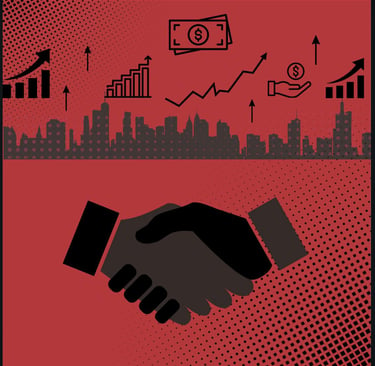Strategizing from 6 cities across the globe
Economics of Trust: The Monetary Power behind Your Thoughts
Today, money is not backed up by tangible assets like gold or silver anymore. This transition marks a major shift in economic philosophy, in which the intrinsic value of money is replaced by societal trust. Hence, leading to the emergence of fiat currencies, particularly after the Great Depression.
INVESTMENTECONOMICSDEMOCRACY
Elie Joe Akiki, Tia Haidar
2/1/20256 min read


Design by Lynn Fanous
In the past money was traded for actual gold. However nowadays, money is traded for consumer purchasing power, downgrading from a symbol for gold, to ink and paper. After the Great Depression of 1929, currencies were no longer directly correlated with gold, but rather built upon common agreement. The whole scheme of defining the value of money became based on how much we trust our market as a whole, and the confidence between suppliers, demanders, central banks, and governments. Because many nations like Lebanon, Iran, Vietnam, and Venezuela have experienced the detriments of untrustworthy trade, it is paramount to analyze how public belief holds an influence in defining the worth of a certain currency.
Today, money is not backed up by tangible assets like gold or silver anymore. This transition marks a major shift in economic philosophy, in which the intrinsic value of money is replaced by societal trust. Hence, leading to the emergence of fiat currencies, particularly after the Great Depression. In 1933, the United States, under President Franklin D. Roosevelt, implemented measures that outlawed gold hoarding. This forced citizens to rely on government-backed paper money instead of physical gold. Later, in 1977, President Richard Nixon signaled global acceptance of fiat currencies by completely detaching the US dollar from gold. Without physical assets, money became a depiction of confidence in governmental policies, economic stability, and central banks. The lack of material backing means that fiat money only holds value because we collectively agree to accept it in transactions. However, as seen in countries like Venezuela and Lebanon, this agreement is delicate and can collapse under mismanagement or corruption.
From a tool for trade to a universally accepted medium of exchange, money now reflects humanity’s increasing reliance on trust as a social construct. Early societies engaged in direct exchanges of goods and services, but this system was inefficient and limited trade. To address this, communities adopted commodity money—items like grains, shells, or metals that everyone agreed had value. Over time, coins made of precious metals became standardized forms of currency. Paper money first appeared in China during the Tang Dynasty but required mutual trust to function. The success of paper currency depended on government assurances of redemption in goods or precious metals. Eventually, governments decoupled paper money from physical commodities, making it an abstract representation of value supported merely by societal consensus and confidence. This reliance on confidence has become even more apparent with the rise of digital payments and cryptocurrencies, which lack physical form altogether. In essence, money has always been a social agreement. It’s simply more explicit nowadays.
Currency based on trust: The IS-LM of your thoughts:
The IS-LM model portrays the equilibrium level of exchange rate based on Investment /Savings and Liquidity Money. This framework helps explain how trust in government policies, monetary stability, and market confidence influence the dynamics of currency valuation.
The IS curve represents equilibrium in the goods market, where investment equals savings. Trust plays a crucial role here;when confidence in the government or economic management erodes, businesses and consumers are less likely to invest. The latter causes a decline in investment, shifting the IS curve downward. This is evident in economies like Lebanon, where political mismanagement led to a plummet in investment, reducing aggregate demand and exacerbating the currency collapse.
On the other hand, the LM curve illustrates equilibrium in the money market, balancing money supply with demand. When public trust in a currency falters, people shift their assets to safer alternatives, such as foreign currencies, gold, or cryptocurrencies. This shift increases the demand for money substitutes and destabilizes the LM curve. In Venezuela, for instance, hyperinflation crucially devalued the bolívar, convincing citizens to adopt the U.S. dollar as a more reliable means of trade and savings, practically sidelining the national currency.
The intersection of the IS and LM curves depends fundamentally on trust. A government’s credibility in controlling inflation, stabilizing exchange rates, and managing fiscal policy ensures that both markets remain in balance. When trust is broken, this equilibrium collapses, leading to economic phenomena such as hyperinflation or rapid currency depreciation, as observed in countries facing severe financial crises.
Risk Premium: The cost of mistrust
The whole scheme of the banking system revolves around making people wealthier in one way or another. However, the interest rate does not reflect the actual increase in somebody’s wealth. As banks introduced themselves, they had to make a certain trade-off for the fact that they are holding your money. People do not give off their money easily in some countries. As the risk of defaulting and ‘taking your money away’ arose, the interest rate became based on a certain expectation of return, which manifested in the risk premium of a country. The higher the mistrust between the population, the higher the interest rate, making banks willing to give a higher rate to counterweight the lack of confidence within the population.
The lack of confidence within trade has triggered a massive economic shock within the Turkish economy. The Central Bank of Turkey declared a 7.86% risk premium, being the highest among all nations. Furthermore, the Central Bank registered an inflation expectation above 20%. The Government is hiding the struggle in maintaining the Turkish economy, which makes us wonder what the essence of this hyperinflation is.
A country like Turkey has been the main destination for many tourists coming from Central Asia, the MENA, and Eastern Europe, with a flourishing industrial and agricultural sector. Even in terms of labor, the country’s flow of refugees caused a labor surplus, leading to an abundance of raw material needed for production growth over and over. However, one major component is missing within Turkish trade—trust. The main drive of the harsh financial situation of the country revolved around lack of trust within the micro and macro trade. The flow of illegal weapons from Turkey to the port of Tripoli in Lebanon caused even higher risk and lack of confidence inTurkish products on an international level.
All in all, the mere fact that trust is not present within the exchanges of a country like Turkey, which has little to no economic drawback, led to the rise in prices and extreme hyperinflation. The central bank is offering around 50% of interest rate in 2024 due to the extreme fluctuations in prices. Trust is key when it comes to economic trade, and while it gets measured in the ‘risk premium’, the detriments are underestimated.
The Backup of Money: Demand not gold
In the last episode of the final season of Money Heist, we witness an agreement of a ‘fake backup’ within the Spanish Central Bank. While the thieves took away the Gold reserves, the Central Bank was able to control inflation expectations just by faking the retrieval of reserves. In the end, it was never about Gold, but rather public trust. Currencies have stopped being directly backed by Gold since 1929, and have become more fluctuant with the influence of supply and demand. Most notably, demand plays a significant role, where our own trust is paramount to keep a good flow of money.
The Lebanese Central Bank possesses the second-largest gold reserve in the MENA, and the nineteenth-largest in the entire globe. However, the currency does not seem to be that powerful. Gold did not gain Lebanese public trust, and it will not if institutionalized nepotism persists. Nonetheless, inflation expectations skyrocketed after the printing money initiative took place to support government spending.
With a higher amount of money circulating within the country, it was normal to have higher prices. Since people could buy more, they would demand more, but not for too long. It is also worth mentioning how some businesses insisted on using foreign currencies like USD or EUR. The gold reserves did not prevent such a dystopian economy from happening. However, it was rather a game of trust. As people stopped believing in the official exchange rate of the Lebanese currency and instead viewed it as a ‘risky store of value’, it became typical for people to demand less of it. What defines the value of a currency revolves around mutual agreements and personal preferences. We cannot deny the role of the Central Bank or the government in defining monetary value. However, the people are the market, and if sellers and buyers are not incentivized to believe that the economy is not going well, they would not have such high inflation expectations.
Conclusion
In conclusion, while trust is not the only factor in defining a currency’s value, it does play a significant role. If the people suddenly agreed on a certain exchange, there would be nothing that can stop it. In the end, the market reflects the interactions of various providers and consumers during day-to-day life. However, the interaction would be crippled and would imply welfare loss if mistrust between the players of a certain economy existed. Households and firms closely follow the news to check the new decisions from either the Central Bank or the Government, yet many fail to realize that they are the major game changer in a nation’s growth.
References:
Connecting Trust and Economic Growth." Deloitte Insights, Deloitte, 2023, www2.deloitte.com/us/en/insights/economy/connecting-trust-and-economic-growth.html.
"Lebanon Economy Now Increasingly Cash-Based Over Lack of Trust in Banks." Al Arabiya English, 17 May 2023, english.alarabiya.net/News/middle-east/2023/05/17/Lebanon-economy-now-increasingly-cash-based-over-lack-of-trust-over-banks-World-Bank.
"Country Risk Premiums." NYU Stern School of Business, 2023, pages.stern.nyu.edu/~adamodar/New_Home_Page/datafile/ctryprem.html.
Hilliard, Mark. "The Gold Standard Ended 50 Years Ago: Federal Debt Has Only Exploded Since." Forbes, 25 Jan. 2021, www.forbes.com/sites/greatspeculations/2021/01/25/the-gold-standard-ended-50-years-ago-federal-debt-has-only-exploded-since/.
"Lebanon Economic Analysis." Credit Libanais, Credit Libanais, 2023, economics.creditlibanais.com/Article/212060#en.
